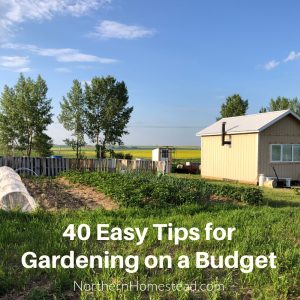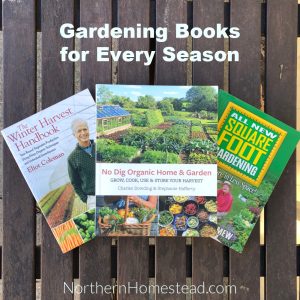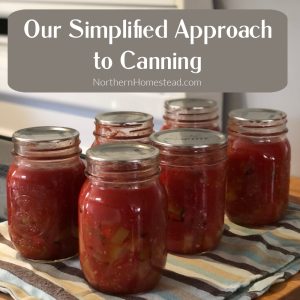
Have you been wondering why November started so mild in our part of the world and continued beautiful? We bought some land and needed to fence it in before the ground freezes. There you have the real reason ;). The fence went up on November 14th and the weather changed overnight. Okay, that at least is my version of the story, and I like it. Now let me tell you all about our new land to build a permaculture property.
The searching for land
Ever since we moved to Canada in 2007 we have been playing with the idea to own an acreage. Honestly, we had no idea what we were looking for or even what would be possible, but we were looking anyway.
One day we shared our dream of owning some local land with an experienced local realtor. Our idea was to purchase an acre or two for under 100 grand. She laughed at us, land here is expensive. But we kept looking anyway.
Whenever something would come upon the real estate market that was close to our price range, we would go to see it. It became kind of a hobby of ours. However, each and every time, we could clearly see there was a catch to the low price. It was either a flooding area, close to a noisy farm or factory, overgrown with no garden or building site, etc. And mostly it was also only close to but still not under our fixed budget.
Years went by, we purchased our house in town and built up our urban homestead. We love it here, but ever so often the thought arises if we only had more land, we could do this and that.
To have more growing space, we gardened at a friend’s farm, and community garden, and we still kept looking for a land not as eagerly anymore though.
One day this 2-acre parcel, which we now call our new land, came up for sale. It was clearly within our price range. However, by now we didn’t even start the car right away, to go look at it. We had seen so many, considering the price, there sure must be a big catch.
Casually, with little expectations, we did drive by one day. It looked quite nice, with no obvious catch.
Here is a short video as we enter the property for the first time. You will not be able to see the video with an ad-blocker.
The new land to build a permaculture Property
Our new land is about an hour’s drive northeast of us. It’s out in the prairie, while we are closer to the foothills. Getting farther away from the mountains was important to us. The summer is a bit warmer there, and chinook winds are not as strong. Those warm winds are quite damaging to perennial plants and cause headaches to sensitive people.
The land is not all flat, it has a bit of a slope to the south, and lower and higher points, making it interesting for permaculture design.

It’s bare land, zoned agricultural, with lots of possibilities. We love small houses, and even though we are not looking to build a house there just yet, to be able to live small or even creative was important to us.
Renewable energy or living off the grid is another factor. Not that we already have plans, but having some options is nice.
An elderly neighbor who spent all his life in the areas, stopped by to say hi. He shared that the two big trees that are majestically growing on the property were planted by his father. However, when he heard that we were planning to plant more trees and fruit-bearing trees, he was about to talk us out of the idea of buying that land. It’s gumbo soil he said.

Quite honestly, we had never even heard of gumbo soil. We learned that gumbo soil is typically defined by the overwhelming presence of very fine particles of clay, with some small amounts of sand and/or organic material. Was there a catch after all?
His daughter added that growing a garden is quite impossible in gumbo soil, because even a little rain makes the area not accessible, and by the time it dries, the weeds have taken over. We learned two things from it, do not dig (and we weren’t planning anyways), and the soil must be quite fertile since weeds grow so well in it.
A friend whose father farmed on gumbo soil praised the good potatoes that soil would produce, there is also something good about it.
The learning continues

The property is a historic school side. I love that fact. The friendly neighbor did not talk us out of purchasing it but made us even more aware that we need and want to learn to manage it.
That former school site will be a part of our lifelong path of learning.
Learning does not only happen by doing but even more so by not doing, by observing, and being still. Patience has never been my strength, I already suspect, that that will be one of my most valuable lessons on that piece of land.
As I shared last week, over the winter months I am taking the permaculture design course, to be able to design the land to permaculture principles and share what I learn with you, so this school site also continues to teach.
Stay tuned for more
We have been sharing our urban home garden with you since 2012. We will also continue to be urban homesteaders. There is a wealth of information about that already on the blog.
Today we are opening a new category ‘Permaculture Property’. We plan to share the whole process from designing, planting a shelterbelt and a food forest, starting a garden, building good soil, and much more.
Some greenhouse ideas, like maybe another Geodesic Dome, or Walipini are in the making. As usual, it will be hands-on low cost.
Most of all we plan to have fun and hope it will be enjoyable, useful, educational, helpful, or just plain entertaining to follow our journey as we build our new land into a permaculture property.
A great read: Building Your Permaculture Property: A Five-Step Process to Design and Develop Land
We invite you to subscribe to Northern Homestead and follow us on Instagram, Facebook, or Pinterest for the latest update.
More posts you might enjoy

Heating your Home with a Wood Stove in Town

Simple Winter Compost Solution

Do food growers need nutritional supplements?

5 Ways to Preserve Vegetables, Fruit, and Herbs

40 Easy Tips for Gardening on a Budget

A Country Garden Cabin

Gardening Books for Every Season

DIY Haircut at Home

Our Simplified Approach to Canning




Congratulations, how excitingly marvelous for you both. Can’t wait to see your progress in your next adventure. JM
Thank you for following along.
I am so happy for you and look forward to learning about permanent culture. We are urban food gardeners near Edmonton.
Being an urban food gardener is great. We will be continuing with that too. So much can be done and grown on an urban lot.
Congratulations; how exciting
So happy for you! How many acres is the land? I will be looking forward to reading your exciting journey!
Thank you. It’s two acres, somehow I forgot to mention that. Will edit it in.
So Very Excited for you as you embark on this new learning and growing adventure!
I know gumbo! We live with heavy – virtually impermeable clay soil here on this farm- BUT THAT IS NOT GUMBO! We own a 1/4 section near Rosemary AB which is classic gumbo, and it grows like no other soil I have ever seen! The fertility is amazing, and of course, so is the water retention! Because we live in a considerably drier area- we are blessed have a pivot on this piece of land- but it is a steep learning curve with water and this soil type! There is a fine line between enough to finish a crop(green-feed mostly) and having just a bit too much, where the cutting and processing of the crop will be delayed because its too wet. Of course, the wind here is a major factor as well in regard to drying as is the density of the plant material, which keeps the sun and wind from reaching that soil! The first thing you will find- which blew my mind the first time I had to trek through a rain muddied driveway to close a gate- this soil STICKS! And I mean it sticks worse than dog poop on a new pair of Gucci’s! Most clay soil will stick and create globs on your shoe that then fall off- not this! It gets larger and larger until you must stop and pry it off yourself! Prior to installing the pivot which we now run, we had pastured part of the 1/4 , and grew alfalfa for hay, using flood irrigation. When we decided to work up that pasture and alfalfa to grow some much needed winter feed, we used a very large 4 wheel drive tractor with dual wheels… It was a a train wreck- as we discovered the bit of moisture subsurface was enough to make that gumbo plug up the space between the dual tires, and render that monster sized tractor useless! Now of course you already know that one shouldn’t be attempting to work any soil when its wet( this really was barely damp)- but the gumbo really really really- will teach that lesson to you! Later when it was drier the process went so much better! When it is cultivated for crops- the smaller equipment works just dandy! I know that you will not likely be using equipment in your processes, but I only use this to illustrate that the stuff is …unique! We also have another farm near Bassano which is essentially sand-and thats a story for another day! I think I’d really rather have the gumbo soil, but we are ever so thankful for that which we do have! AS always- like my instructor at Olds College taught so well- ADD ORGANC MATTER- Always the best place to start! Best of Luck with your new land! Enjoy!
Thank you, Laura! So appreciate you sharing your real-life experience. I was hoping someone like you would jump in on a comment section. Your experience is very encouraging. Looking into the vegetation that is already there, I could tell that the soil must be fertile. Of course in the pictures, it all looks dead since it’s November now. But I’m looking forward to many surprises come spring.
It is interesting that you point out that gumbo is not clay. Google search usually showed clay, when I look for information on gumbo. However, just looking at the soil, I can already tell it isn’t clay. As you say, adding lots of organic matter is the plan.
Clay or not clay? Sorry, I’m confused, but I’ll comment anyway. 🙂 We live on and garden in heavy, black clay, and our land is in the middle of fields much like yours. Is it really “gumbo”? Don’t know. Anyway, this soil definitely has advantages. It is super fertile. It retains moisture even in a drought. This summer in Manitoba, with hardly any rain, my tomatoes still grew and produced like crazy with only a little watering from time to time. Potatoes too! With a permaculture and no till mindset, you won’t have to worry about the land being unworkable. And if you need to dig for some planting, you will get to know the soil and the best times to do that. And yes to tons of compost and cover crops which you can just cut down, don’t have to till in. Your friendly neighbour’s warnings are probably based on modern big agriculture practices which you won’t be using.
Three words of caution though . . . 1) if your land has been farmed using cides (insecticides, fungicides, herbicides), it will take a few years for it to find a natural balance again, 2) You’ll have to plan with spray drift in mind because when the neighbouring fields are sprayed it could impact your plants, and 3) Plant trees asap! They don’t grow as fast in this kind of soil (in my experience).
May God bless your land and your efforts!
Thank you Heather for your comment. Gumbo as I understand is clay, just the structure is very fine, so it reacts differently. Thank you for your words of caution. To our knowledge, that corner of the section has not been farmed. Only the far southwest corner has. And the vegetation there is different, we could tell right away. Spray drift was a big concern of ours too. Our neighbor was very understanding of our desire to grow organically. He is an enviramentalist himself. The land is also not prime crop land. We will see how it turns out, but we are hopeful.
We have ordered lots of shelterbelt trees, hopping for fast growth.
Hello Anna,
If you need advice, help or input on your soil and it’s clay content, you could contact Takota Coen https://vergepermaculture.ca/building-your-permaculture-property-listing-page/. Coen Farm is located in AB, near Ferintosh.
Thank you Ingrid. We have been touring Coen farm several times. It’s so beutiful and insiaring. They sure are a great exsample on what can be done.